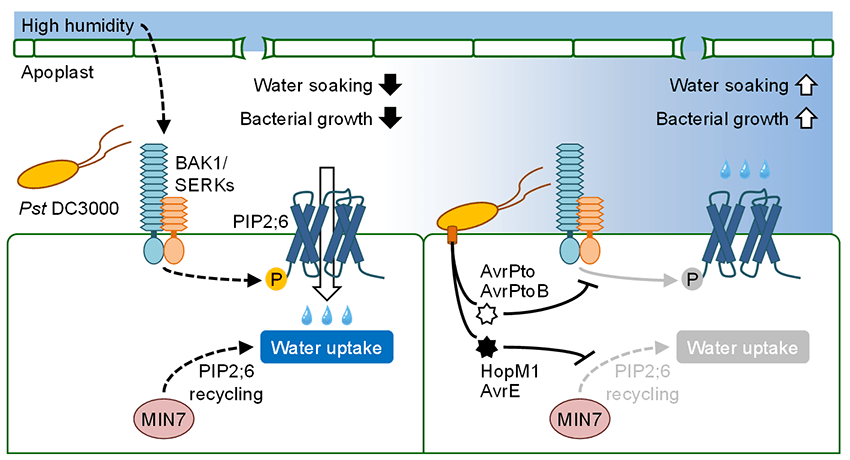2023.07.12
Tug-of-war between plant and bacterial pathogen under high humidity
Plant Immunity・ Assistant Professor ・ Shigetaka Yasuda
Atmospheric humidity has a significant impact on the colonization mode of microbes in terrestrial plants, and high humidity often favors plant diseases. The bacterial pathogen Pseudomonas syringae pv. tomato (Pst) DC3000 develops a water-soaked leaf apoplast with type III secretion effectors (T3Es), thereby promoting pathogenicity under high humidity. However, plant defense against bacterial water soaking remains elusive. We found that of 13 Arabidopsis plasma membrane aquaporin, PIP2;6 is specifically required for resistance against bacterial water soaking under high humidity. PIP2;6 dysfunction permits an effector-less Pst strain to cause water soaking and extensive proliferation. PIP2;6 phosphorylation is induced under high humidity, through the receptor-like kinase BAK1 (belongs to SERK family), and contributes to water uptake and resistance against bacterial water soaking. Conversely, Pst DC3000 employs different T3Es to inhibit the phosphorylation and intracellular trafficking of PIP2;6 for water soaking. Our findings indicate that control of water uptake, in part through phosphorylation of a host aquaporin, provides a critical step in bacterial resistance under high humidity.

Figure. Schematic diagram of PIP2;6-mediated water soaking resistance under high humidity.
Upon exposure to high humidity, Arabidopsis induces PIP2;6-mediated water soaking resistance through its phosphorylation and intracellular transport via BAK1 (and other SERKs) and MIN7, respectively. Conversely, Pst DC3000 inhibits BAK1 and MIN7 pathways via T3Es to overcome PIP2;6-mediated water soaking resistance.
Shigetaka Yasuda NAIST Edge BIO, e0014. (2023).
